By Debra Whitman
Executive Vice President and Chief Public Policy Officer
AARP
Peter Rundlet
Vice President
AARP International
Holly Schulz
Senior Advisor
AARP
Download PDF
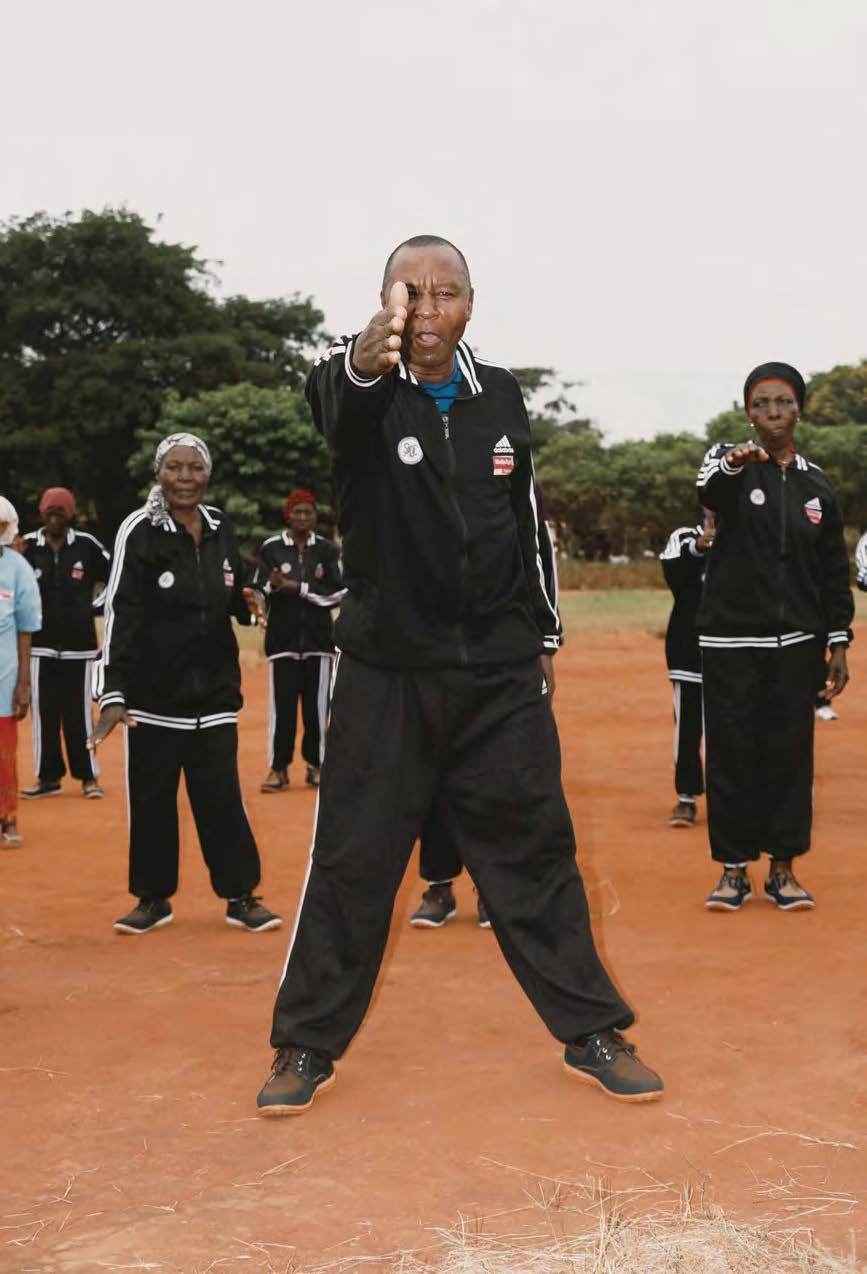 The Kabuku Active Ageing Club meets twice a week, on Tuesdays and Saturdays, for exercise and income-generating activities.
The Kabuku Active Ageing Club meets twice a week, on Tuesdays and Saturdays, for exercise and income-generating activities.
As we pulled up to the red clay field just after 7 a.m., the sun was rising and the mist from the morning dew had started to evaporate from the surrounding grasses. We had come to the remote village of Kabuku, in the Tanga region of Tanzania, to participate in the morning exercises of the Kabuku Active Ageing Club. As we arrived, we saw more than 100 older Tanzanians sporting matching track suits begin to warm up for their daily routine.
As they moved, they engaged with their coaches in a call-and-response exchange:
Coaches calling:
Wazee Mpo?!
Older people, are you there?
Participants answering, pointing in unison behind them, into the past:
Ndiyo! Walikuwepo!
Yes! They were there!
Participants, now pointing at the ground, indicating the present:
Tupo na!
We are here!
…and finally, pointing forward, toward the future:
Wataendelea kuwepo!
And they will continue to be here!
We watched, mesmerized, as spectators. But not for long. They summoned us to participate, and how could we say no? So with a bit of natural trepidation, we agreed to join the group of these 60-80 year olds moving with grace and agility. For the rest of their 60-minute workout, we followed their lead.
This came toward the end of what had been an incredibly enlightening 15-day odyssey.
How Did We Get Here?
For the last several years, we have traveled to countries that have been exemplars on supporting aging populations to more deeply understand and share the effective policies and promising practices they employ to support their older adults. In past editions, we reported on countries that include Japan, Singapore, the Netherlands, and New Zealand — each of which have two things in common: they all have populations with a high percentage of older adults, and they all represent very developed, high-income societies.
But population aging is taking place in every part of the world — and most rapidly in lower- and middle-income countries (LMICs) — so we wanted to explore how developing countries are preparing for the significant demographic shift coming over the next few decades. Although Africa is currently the world’s youngest continent, it will experience a more than 400 percent increase in its population of older adults between now and 2050. By that year, a whopping 80 percent of the world’s older adults will reside in LMICs. Inspired to act, we knew we had to learn more to help these countries avoid growing old, before they grow rich.
Because this was new and important territory for us, we decided to visit and study two illustrative countries for this exploration to give us a broader (and comparative) sense of how LMICs in Africa are currently supporting older adults. Though both countries are considered lower-middle income, the average Kenyan has nearly twice the income of the average Tanzanian. Moreover, our learning journey included Zanzibar, which is a semi-autonomous region that makes up part of the United Republic of Tanzania; it has its own president, parliament, and policy approaches, including with respect to older persons.
In addition, it is important to note that our experience would not have been as successful as it was without the wonderful partnership we have with HelpAge International. HelpAge has significant offices in both countries and fantastic staff on the ground who were extraordinarily helpful to us. They introduced us to leaders in government, with older people in communities, and provided essential logistical support to ensure a smooth trip. We are very grateful for all that they did for us and for all they do to support older persons everywhere.
Together with AARP CEO Jo Ann Jenkins, over 15 days we traveled thousands of miles, engaged in more than 40 meetings and connected with hundreds of people — all with the goal of taking a deep policy and cultural dive into Kenya, Tanzania, and Zanzibar. Top priorities included both meeting with stakeholders in the larger cities of Nairobi and Dar es Salaam and traveling to rural areas in the two countries so that we could more fully understand the systems of support available to older persons. We met with Kenyan, Tanzanian, and Zanzibari government officials at national, state, and local levels; U.S. officials and senior representatives from international organizations like the United Nations; civil society leaders along with advocates for the rights of older persons; private sector leaders and social entrepreneurs; and academics and other aging stakeholders. Most importantly, we met with hundreds of Kenyan and Tanzanian older persons themselves — including Maasai elders, members of Older Persons Associations (OPAs), and active aging clubs, among others.
Demographic Basics
Kenya’s population is nearly 57 million, with an average age of just under 20 years old and life expectancy of approximately 67 years. Tanzania, meanwhile, has a population of nearly 69 million, with the average age about 18 years old and life expectancy of 66 years. In both countries only 3-4 percent of the population is over 65 years old today. Approximately 29 percent of Kenya’s population lives in urban areas compared to approximately 37 percent of Tanzanians — and the trend in both countries is toward greater urbanization. The official languages in both countries are English and Swahili, yet both have more than 40 ethnic groups, and more than 60 ethnic languages are spoken in each country.
The average GDP per person in Kenya is approximately $2100, and that falls to $1100 for the average person in Tanzania. Zanzibar, an archipelago off the east coast of mainland Tanzania that has been semi-autonomous since the formation of the United Republic of Tanzania in 1964, has its own government and laws. The population of just under 2 million is of both African and Arab origin, and the overwhelming majority is Muslim. Despite the large and youthful populations that exist today, Tanzania will see a 370 percent increase in the number of people 65 and older, and Kenya will see a 450 percent increase.
Age Justice in a Youthful Continent
We began our journey in Nairobi, the capital of Kenya, and immediately sat down with our longtime partner, HelpAge International, a global non-profit that works to improve the lives of older people around the world. Active in Africa for decades, the organization has 180 network members in over 90 countries. We were fortunate to be joined by their CEO, Cherian Mathews, for part of our time in Kenya, and we had the support of their dedicated staff, who helped connect us with more than a dozen of their affiliated network organizations, each of which is also working to support Kenya’s older population. Carole Osero-Ageng’o, HelpAge’s Africa Regional Representative, captured their mission this way: “We are seeking age justice in a youthful continent.”
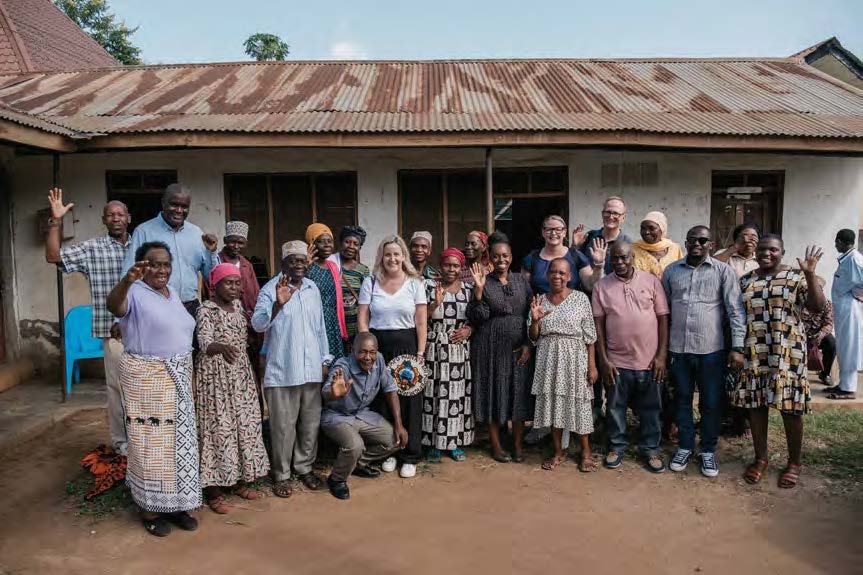
Executive Director of HelpAge Tanzania Smart Daniel (back row, second from left) convened a meeting of the Korogwe TC OPF and the Leaders of the Mtonga Active Aging Club Income-Generating Group members
HelpAge has been instrumental in pioneering and promoting the development of Older Persons Associations (OPAs) around the world. OPAs are community-based organizations that consist of older persons who come together to improve the lives of older people. OPAs can vary in structure, but they tend to actively engage older persons, including in their leadership, to address interrelated needs such as health and social care, economic livelihoods, and more. They are very effective in organizing and representing the voice of older persons before government leaders and have become vibrant, powerful agents of change. They work to ensure wide ownership and participation from diverse older people including women and men of all income levels, often prioritizing those from disadvantaged groups. With origins in Asia, the OPA model has spread to countries around the world. HelpAge has been particularly effective at developing OPAs in Kenya and Tanzania; in fact, there are now more than 20,000 OPAs in Tanzania alone.
We had our first opportunity to meet with OPAs in the remote Maasai villages of Ntulele and Rotian in Narok county. The Maasai tribe is among the largest in Kenya, with approximately 1 million members. Their ancestral homeland is the Maasai Mara, which transverses the Tanzanian border into the Serengeti, where another 430,000 members live. Titus Abworo, the executive director of the Ageing Concern Foundation and who works closely with the Maasai OPAs, was able to facilitate and translate a warm exchange with the Maasai elders in both settlements. During our discussion, we learned about how the elders were working to inform a technical working group on age equality and how they are working in partnership with the Ministry of Health to ensure that Maasai elders were getting access to free health services, including COVID vaccinations. It was clear that they were active and engaged and that the OPAs helped tie them together socially.
Back in Nairobi, we met with policymakers, civil society organizations, and private sector leaders. Starting with Anne Waiguru, the governor of Kirinyaga County and chair of the Council of Governors (of which there are 47), we learned about the dire need for more long-term care options for Kenyans. We also met with the leadership of Nairobi County, home to over 100,000 older adults. The governor’s staff explained that the rural-to-urban migration was increasing the number of older people living in the city — and that life was hard for them. The current infrastructure is not designed for people with accessibility issues, housing options are limited, and social isolation is a growing problem in the cities. We explored the possibility of Nairobi being the first city in Africa to become part of the World Health Organization’s Age-friendly Cities and Communities program; we plan to support them in making the pledge.
Recognizing that the Kenyan government has many competing priorities and limited resources, we were focused on encouraging U.S. policymakers to do more to help bring an aging lens to the investments the U.S. is making there, through USAID and its support for the multilateral development banks. We had a productive meeting with U.S. Ambassador Meg Whitman who quickly grasped, for example, that the mass transit system the Kenyan government is building today will be around for decades and must be designed to accommodate the population that Nairobi will soon have.
We met with David Gosney, the mission director of USAID, and implored him to consider the aging population in both their development and humanitarian response programs. Older adults have unique and special needs during humanitarian or conflict crises and USAID does not currently recognize older persons as a vulnerable group in these situations. We also met with leaders at the UN Refugee Agency, who shared that Kenya and Tanzania are each hosting hundreds of thousands of refugees who have come to escape conflict and other crises in surrounding countries. Of these, as many as 28 percent are older adults, many with unique needs.
Like every country we have ever visited for our annual knowledge-gathering missions, in Kenya we saw both progress and hardship. Though estimates vary, fewer than 15 percent of older adults belong to a pension scheme and nearly 60 percent of adults over 65 continue to work.
In 2018, the Kenyan government introduced a universal social pension for all adults over age 70. The Inua Jamii Senior Citizens’ Scheme provides a cash transfer of 2,000 Kenyan shillings (approximately 15.50 USD) per month. The payments go directly to individuals (vs. households) through the mobile payment system, with little hassle — when it operates properly. But we also learned that the payments can sometimes be erratic and that many potential beneficiaries still need to be enrolled. The government has also created a National Health Insurance Fund that workers in the formal economy can contribute to. It is insufficient but incremental progress is being made.
A Nation on the Move
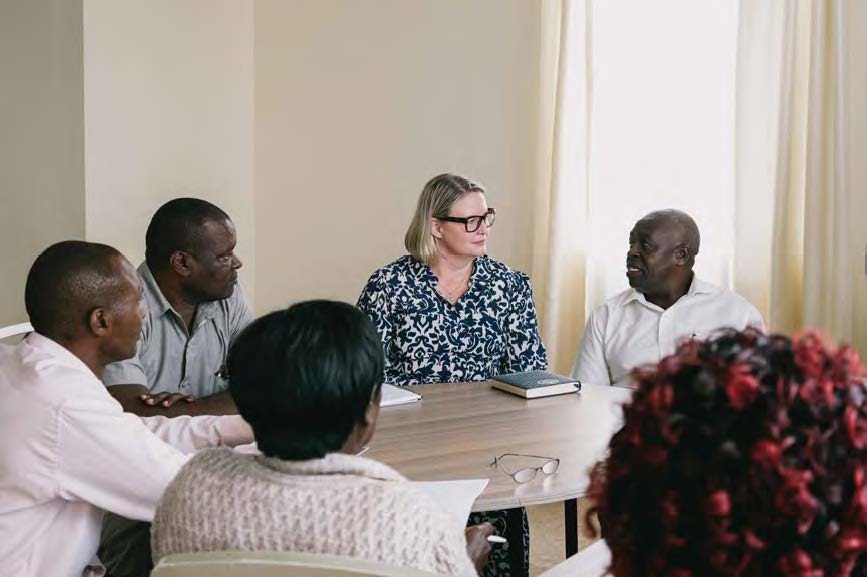 During our time in Nairobi, we heard from the members of HelpAge International Kenya’s Technical Working Group
During our time in Nairobi, we heard from the members of HelpAge International Kenya’s Technical Working Group
To be clear, Kenya is a dynamic, growing country in which many are thriving. We met with more than two dozen remarkable private sector leaders from a variety of fields, and every one of them was optimistic about Kenya’s future. Maxwell Okello, CEO of the American Chamber of Commerce in Kenya, told us of Ambassador Whitman’s efforts to promote investment in Kenya, including that Kenya is: home to Silicon Savannah, a growing innovation and tech hub; it produces a stunning 90 percent of its on-grid electricity from renewable sources; and it created MPesa, the largest mobile money market in the world. Great things are happening in Kenya.
Among all our amazing experiences in Kenya, the highlight was visiting the Kibera Day Care Centre for the Elderly (KDCCE), founded by the humble and heroic Agnes Kariuki — a true legend whom we had the pleasure of meeting. In 1989, after her work as a health and sanitation field worker allowed her to witness the difficult plight of older people living in Kibera — Africa’s largest “settlement,” or slum — Agnes decided to act. Starting off modestly by working with 17 older adults, KDCCE, through Agnes’s relentless commitment, has grown to support more than 3,200 older adults, many of whom are destitute. Today KDCCE’s programs and services include medical care, literacy training, a feeding program, and social activities to prevent loneliness among older Kenyans. The whole environment is infused with an energetic warmth and enthusiasm, and a palpable sense of empowerment.
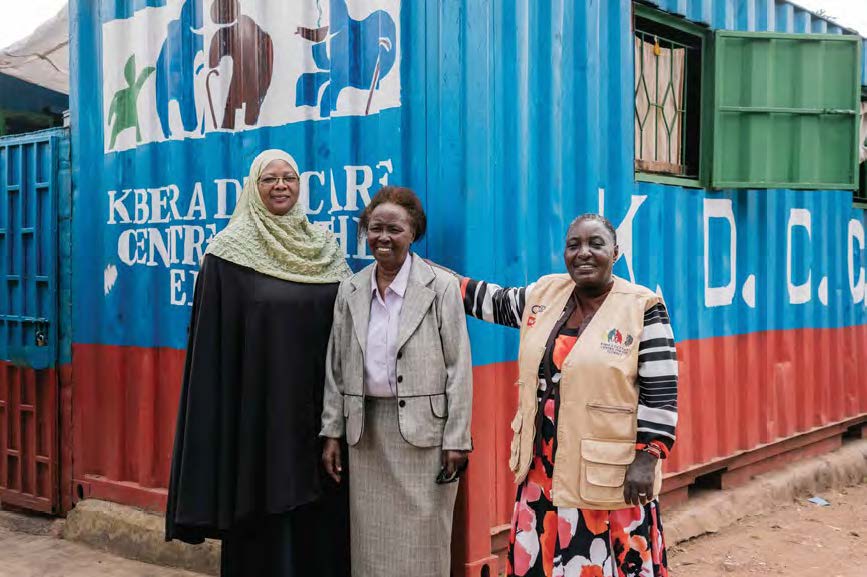 Agnes Karuki (on right), founder of the Kibera Day Care Centre for the Elderly (KDCCE), pictured with her colleagues Yasmin Abdulrahman and Alice Nyakinyua
Agnes Karuki (on right), founder of the Kibera Day Care Centre for the Elderly (KDCCE), pictured with her colleagues Yasmin Abdulrahman and Alice Nyakinyua
Soon after our return to the U.S., we received the sad news that Agnes Kariuki had suddenly passed. It is rare to meet a true hero in life, and we all knew that, with Agnes, we had. Starting and growing her center by operating out of converted shipping containers and temporary structures made of corrugated tin, she was a champion in every sense of the word, advocating for the rights of older people and working ceaselessly to meet their needs. Agnes’s legacy is one of hope, compassion, and unwavering dedication to supporting older persons. And to honor her legacy and because the institution she created continues to endure and thrive as it supports older persons in Kibera, AARP created a special award to provide significant financial support for KDCCE for the next three years.
As for our own trip’s mission, we were so fortunate to learn from Agnes’s invaluable insights and experience. Her resourcefulness, creativity, and strength will both inspire and inform the work we all do on behalf of older adults.
“Haven of Peace”
From Nairobi, we traveled to Dar es Salaam, which means “haven of peace.” Though the official administrative capital moved to Dodoma in 1974, Dar es Salaam remains the largest city in Tanzania and its financial center. Here, too, we were guided by an incredibly effective team from HelpAge — in this case, HelpAge Tanzania, led by the inimitable Smart Daniel, their long-serving country director. Like other lower-middle-income countries, Tanzania faces many development challenges, including poverty and high rates of labor market informality, but it is an increasingly popular tourist destination and its economy is growing quickly. Importantly, it was among the first countries in the world to adopt a National Plan on Aging — in 2003, only one year after the adoption of the Madrid International Plan of Action on Ageing, which is the global non-binding treaty that urged all countries to adopt national aging plans.
In Dar es Salaam, we met several senior Tanzanian officials who traveled from Dodoma to describe the government’s efforts and aspirations for older people. Dorothy Gwajima, the Minister of Community Development, Gender, Women, and Special Groups (the “Minister of People” as she preferred to call it), provided insights into the 3.4 million older persons in Tanzania today. The majority live in rural areas, 43 percent live in poverty, and more than 70 percent are still working and economically active. She discussed how the ministry is reaching people on the ground by working with national councils connected to the country’s 26 different regions and over 3,000 wards. She is working to build better institutional capacity and coordinate efforts with the Minster of Health. As she lamented, fewer than 6 percent of older persons receive a pension. On the more encouraging side, she expressed hope that Tanzania would soon ratify the Protocol to the African Charter on the Rights of Older Persons — a significant, if imperfect, regional treaty to establish mandatory legal protections for older persons.
We also went to the U.S. embassy, where we met with the State Department’s Deputy Chief of Mission and with USAID Country Director, Craig Hart, who shared that life expectancy in Tanzania had expanded by 19 years between 2000-2019, a stunning achievement that is credited in part with the reduction of HIV cases and a robust Community Health Worker program. Tanzania, he said, has been doing an admirable job of getting “retired, but not tired” doctors to work in community health centers. We urged USAID to elevate aging in its development agenda and shared some of the great work that HelpAge was doing on the ground through its vast network of Older Persons Associations. Most people have mobile phones now, and with more than 20,000 OPAs, we noted that there is great potential to both mobilize and inform older Tanzanians quickly to achieve positive outcomes for older persons.
Zanzibar: A Big Role Model from a Small Place
The day after meeting with the national government officials, we woke up early to take a small plane for a short flight from Dar to Zanzibar. Though it is probably more famous for its golden beaches, Zanzibar has been a pioneer in supporting older persons, making history when it was the first country in East Africa to establish a universal cash transfer pension that is fully funded by the government. Adopted in 2014 by the Revolutionary Government of Zanzibar (the official name of the semi-autonomous government), the Zanzibar Universal Pension Scheme (ZUPS) has provided every Zanzibari citizen over age 70 with a modest noncontributory pension since April 2016. Specifically adopted to help address the financial precarity of older adults in Zanzibar, most of whom were living in poverty, the pension initially provided 20,000 Tanzanian shillings (~ 9.00 USD) per month. Though small, extensive impact studies have made clear that ZUPS has had a positive impact on individual wellbeing, food security, and health expenditure. Moreover, the benefits often extend to recipients’ households.
These successes made us all the more excited to meet with President Hussein Mwinyi and members of his cabinet to discuss their efforts to improve the lives of older people. In 2022, President Mwinyi declared a 150 percent increase in the pension, to 50,000 shillings. During our meeting, President Mwinyi said that he would like to increase it further, saying, “It is not enough.” More significantly, he noted that “the pension starts at age 70; we would very much like to bring it down, to at least 60 . . . We will do our very best to make sure we achieve that.” Our meeting was recorded by the media and this declaration was played and replayed television. To learn more about his support for older persons, please see President Mwinyi’s personal article in this edition of The Journal.
It is clear that Zanzibar’s admirable efforts are being recognized as a model. Its’ policies are frequently cited by policymakers in Tanzania and other countries in the region who seek to emulate them. Though small, Zanzibar is leading the way in East Africa.
The progress in Zanzibar would not have been possible without the organized advocacy of the OPAs there. After walking through the remarkable UNESCO heritage site of Stonetown, the oldest part of Zanzibar City, we traveled to rural areas to meet with members of JUWAZA (the Swahili acronym for the Zanzibar Association for Retirees and Older People) and the Juyawaza Age Care Organization. Both organizations convened large groups of their members to sit with us and share how they have worked with each other and with HelpAge-Tanzania to create a strong voice for older people in Zanzibar. One passionate older woman told us, “Advocates must have the audacity to press their demands.” These OPAs’ lack of resources certainly did not impede them from achieving a quite sophisticated and organized movement. It was a privilege to see them in action.
The next morning we flew back to the mainland, to the remote town of Tanga, and from there we drove overland to Korogwe. Our goal for that trip: to better understand the wide variety of challenges faced by older people in rural areas of the region. Economic hardships prevail there, exacerbated by limited employment opportunities, sparse infrastructure, and little access to health care services.
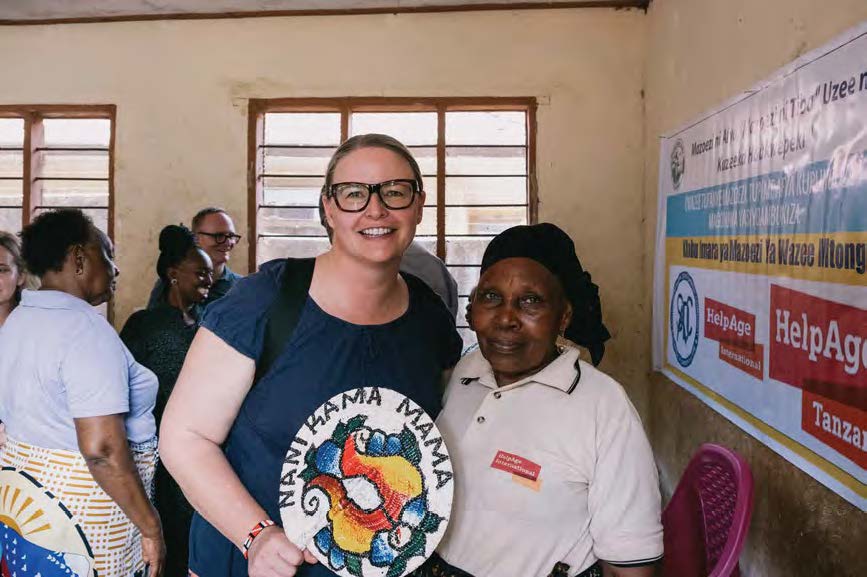 With Fatuma Rajabu Saidi, Chairperson of the Mtonga Active Aging Club, who also serves as an Older People Monitoring and a Home- Based Care Provider. The Swahili saying on the fan is “nani kama mama,” meaning “who is like a mother.
With Fatuma Rajabu Saidi, Chairperson of the Mtonga Active Aging Club, who also serves as an Older People Monitoring and a Home- Based Care Provider. The Swahili saying on the fan is “nani kama mama,” meaning “who is like a mother.
In Korogwe we gained insights from discussions with the Older Citizens Monitoring Groups (OCMGs), which work closely with the OPAs to create citizen-led, accountability-of-government services. The OCMGs monitor the implementation of policies and services that are intended to benefit older persons. In this region, they have emphasized the need for age-friendly health care services. While there, we were able to visit Maguna Hospital to see how they had created special service areas specifically designated to administer health services to older persons. They have been able to get at least two paid health care workers in every ward, and they were working to create a monthly dementia clinic. We also met with several dozen older persons who gather regularly for income-generating activities (and we were happy to buy several of their hand fans to fend off the overwhelming heat!).
Even in the most resource-challenged areas, we discovered, older people have proven to be effective advocates for themselves. William Mwakilema, the district commissioner of Korogwe, told us, “Community is what holds us together.”
Optimism and Action, Defining Present and Future
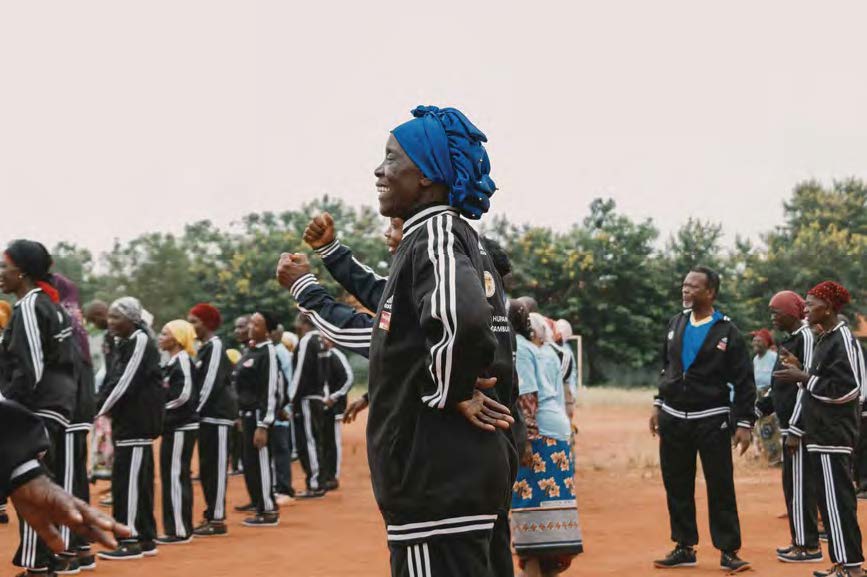 The Kabuku AAC’s tracksuits were provided by HelpAge Tanzania through the SADC Project.
The Kabuku AAC’s tracksuits were provided by HelpAge Tanzania through the SADC Project.
After dozens of site visits and meetings — in fancy government offices as well as hot and dusty rooms — and connecting with hundreds of older persons themselves, we emerged exhausted but energized. The challenges for older people in Kenya and Tanzania are real, but older people are making a path for themselves by walking it. So it was, that we found ourselves early in the morning, on our last day before the long drive back to Dar es Salaam, among more than a hundred strong and optimistic members of the Kabuku Active Ageing Club, screaming out loud in Swahili:
“Older people were here! Older people are here! And older people will be here!”
Of that, we have no doubt.
_________
Suggested Citation:
Whitman, Debra, Peter Rundlet, Holly Schulz. 2025. “Aging in East Africa.” AARP International: The Journal, vol. 16: 96-117. https://doi.org/10.26419/int.00368.023.